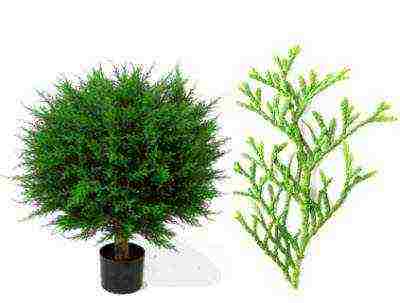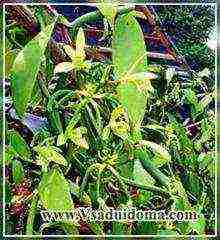Content [show]
These are the most unusual of the green inhabitants of our planet. Since ancient times, each of the lithops has lived in a separate territory, among fragments of stones and rocks, copying the shape and color of the surrounding boulders. With visual contact, it is impossible to determine that these are plants until you touch them with your hands. How to grow lithops, amazing and amazing living stones, this article will tell.
Description of lithops
Living stones of lithops are characterized by a huge variety of petal colors during flowering - from carmine and lilac to white, cream, yellow. Flowers in appearance differ little from ordinary daisies and are comparable in size to or exceed the leaves. And when the mass flowering of living stones begins in their habitat, then this spectacle is one of the most delightful in nature.
Lithops Lithops is a genus of succulent plants of the Aizov family, numbering more than 30 species. Such "pebbles" come from the sandy and rocky deserts of Namibia, South Africa and Botswana. Living in natural conditions, they have adapted to the harshest conditions of existence in an arid desert climate. And in order not to become the prey of wild animals, which sometimes have nothing to eat in these harsh places, they disguise themselves as rocky ground with such care that you can distinguish them from real stones only if you touch them.
Lithops form vast colonies, populating dehydrated places of the planet, on the most impossible soil - quartz, limestone, granite. The terrestrial part of lithops consists of two thick leaves that have grown together, containing a reserve of moisture, consuming it during the most severe drought. The gap between them is shallow or can reach the ground itself, cutting the "stone" into two halves. New leaves and inflorescences appear from this cut.
Young lithops shares a root with the mother plant until it dies. The color and pattern of the leaves follows the pattern and color of the stones of the surrounding area. The underground part of the lithops consists of a short stem and a long root that goes deep into the sand in search of life-giving moisture. With the onset of drought, the roots pull the entire plant in depth so that it practically disappears from the surface. Lithops flower is similar to chamomile - in young plants they close at night. This way they save moisture.
How to care for lithops
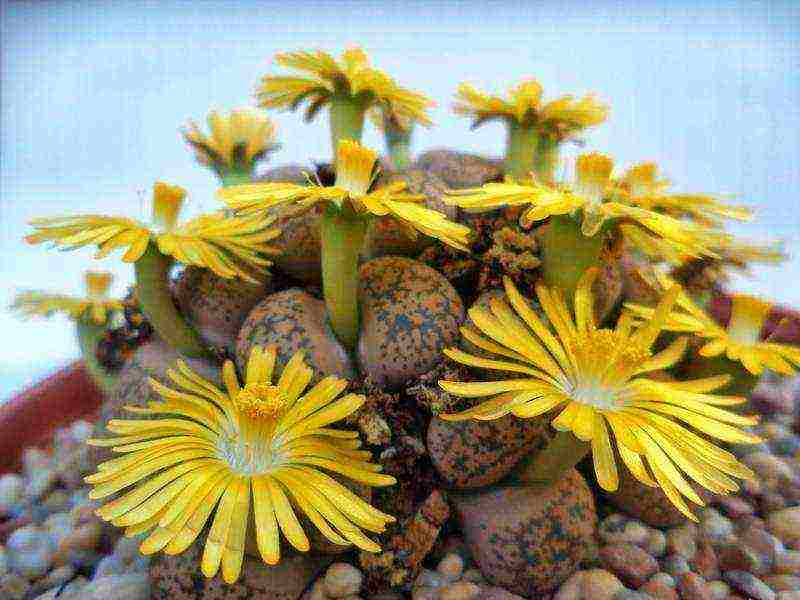
Living stones lithops how to care for succulents at home Reproduction by seeds Photo of flowers
In order to avoid mistakes when keeping lithops, one should understand the cyclical nature and conditions of its growth in the homeland.Living stones are often sold, and the only reason for the low prevalence of these interesting plants is a poor knowledge of their biology and, as a result, improper care, which leads to their death.
It is a very decorative but also extremely sensitive plant. They peek out from under the sandy ground to get their share of the sunlight. These small succulents are extremely varied in color. The top of the leaves is mottled and can be dark red-brown or yellowish, orange, blueberry, dark purple.
Spots, lines and streaks on the surface are a kind of windows through which the plant covered with sand absorbs weak light. With the onset of spring, a pair of new leaves appears from the gap, which replaces the old ones, which have given up their strength to resume growth.
- Lithops feels great on light windowsills, reacts positively to airing.
- He needs direct sunlight or artificial lighting for 12 hours every day for 4 hours.
- In low light, the plant may die.
- In winter, it is worth keeping the temperature at 10-15 degrees. Since December, watering is completely stopped, resuming in March. Lithops can be sprayed only occasionally. Its life cycle ends - it consumes moisture from dying leaves.
- Watering begins in spring, when a new life cycle begins, resulting in new leaves.
The best way to water is to put water in a pan and after 10 minutes pour out the rest. Or place the container in a bowl with moist peat, which is periodically moistened. At the end of our summer, the life of the lithops stops again - watering should be stopped. In September, lithops bloom, after which watering is reduced again. During the growing period, you can put the container with "pebbles" outside under a canopy to prevent the ingress of rain drops.
Leaving for a dormant period, it ceases to develop, and its leaves fade. Having noticed these signs, it is worth stopping watering and placing the pots in a bright, cool place.
Twice a year, you can fertilize with complex fertilizer, which should be added to the water for irrigation in minimal quantities. This should only be done for plants that have not been transplanted for more than 2 years.
Soil for lithops

Growing lithops How to grow lithops Reproduction and care photos of species
For live stones, pots with a height of about 7 cm are selected. When selecting a container, the size of the root system is taken into account - too much soil will lead to acidification, decay and death of the root system. Be sure to arrange drainage at the bottom of the planting tank.
- The soil substrate can be prepared from the store soil for succulents, sand, perlite (1: 2: 2).
- Live rocks can be planted in wide bowls in combination with other desert succulents.
- It is necessary to grow living stones in groups - this is how they grow in nature, closely pressed against each other. Planted alone, they grow poorly, do not bloom and may die.
- It is good to do mulching with small decorative stones: this will have a positive effect on the microclimate in the soil and will create an additional decoration for the composition.
Most succulents are not picky about the composition of the soil - the main thing is that it passes water well and does not contain a lot of humus. To reduce acidity, crushed wood ash or chalk is included in its composition.
Diseases and pests of living stones
- Well-groomed lithops are rarely susceptible to pest attacks and the development of diseases.
- If signs of the disease are noticed, the affected particle is cut out with a knife, and the wound is dried and sprinkled with activated carbon.
- Sometimes they are affected by mushroom gnats or worms, which happens with excessive watering. In this case, the soil substrate is watered with a very weak solution of potassium permanganate, followed by drying.
Lithops from seeds at home
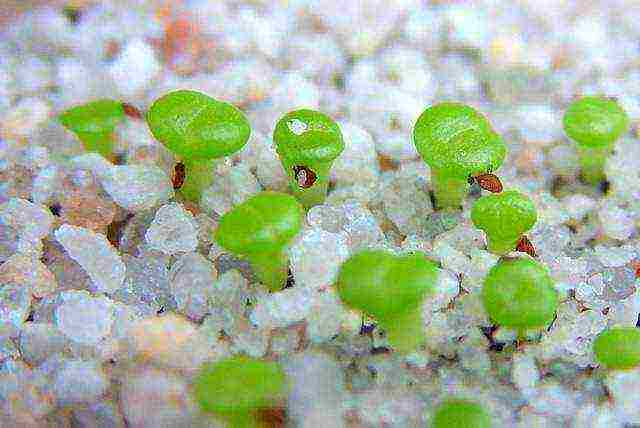
How to grow lithops from seeds Growing lithops from seeds Photo of seedlings
Lithops propagation by seeds is quite simple. It is better to immediately purchase a bag of the mixture - then you will get many different types at the same time.
- Sowing is carried out in a wide, shallow dish with a transparent lid and drainage holes.
- The soil mixture for sowing is prepared from standard store soil, sand, perlite (1: 2: 2).
- The soil is thoroughly moistened and seeds are distributed over the surface as rarely as possible. Sprinkle thinly with sand on top, cover the container with a lid or glass, cling film.
- Seeds do not lose their qualities for a long time, so the germination rate can be 100%. They germinate unevenly. The first ones may appear during the first week.
- To accustom small plants to air and for ventilation, the lid on the container is lifted every day.
- Watering is carried out through a pallet - water is poured into it and drained after a while.
- Pebbles grow very slowly. Sometimes they fall on their side, since the roots are not yet sufficiently developed - in this case, we help them to take a vertical position with a toothpick, pressing them a little into the ground.
- It is better if the container with seedlings is placed in a sunny place.
The first flowering under optimal conditions can occur 3 years after sowing.
Living stones grow very slowly - this can be used to create mini-compositions that will remain in their original form for several years. Lithops literally emit positive energy that people in the room feel.
When properly planted, they require almost no maintenance - you can forget about them for several weeks. And "pebbles" will only be grateful to you for this, because they do not like excessive attention. Such a composition is ideal for people who cannot devote enough of their time to caring for indoor plants, but want to have a living corner at home. Lithops will perfectly cope with this task, creating a piece of the unique landscape of the sultry desert in the house.
Lithops species
Living stone Conophytum Lithops Conophytum

Succulent Lithops Conophytum Lithops Conophytum photo How to grow
Its leaves are connected, and at the top of the rounded "stone" there is a scanty hole for flowers and leaves of the next season.
Living stone Argyroderma Lithops Argyroderma

Lithops argyroderma Lithops Argyroderma how to grow a photo
Imitates sharp pebble chips, its paired leaves are somewhat pointed at the top and loosely adjoin each other. The name of this species alludes to the silver color of the leaf skin.
Living Stone Fenestraria Lithops Fenestraria and Fritia Lithops Frithia
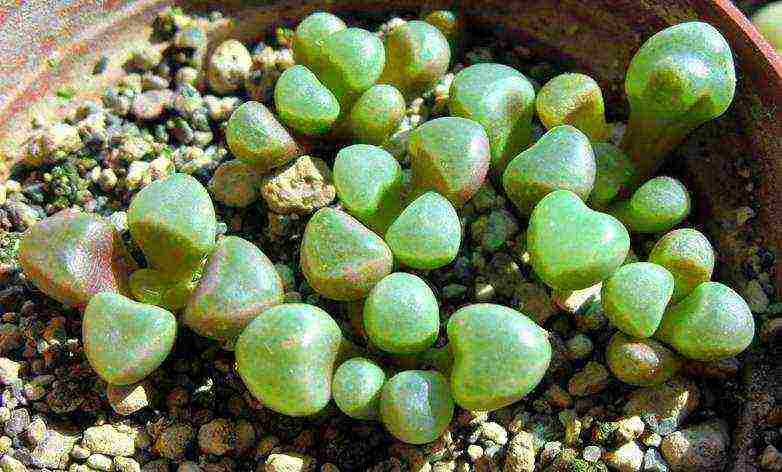
Lithops fenestraria Lithops Fenestraria growing and caring for succulent photos
Keg-like leaves form continuous thickets. They are slightly distant from each other so that the rounded shape of each does not undergo deformation.
Lithops pseudo-chopped Lithops pseudotruncatella
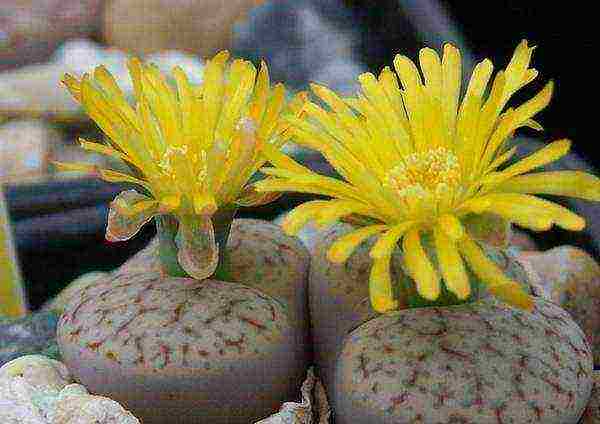
Lithops pseudo-chopped lithops pseudotruncatella photo of flowers
It is distinguished by the presence of a shallow break and a pinkish-gray color of leaves with a pattern of a more intense shade. Golden yellow buds appear in the fall.
Lithops salt tolerant Lithops solicola
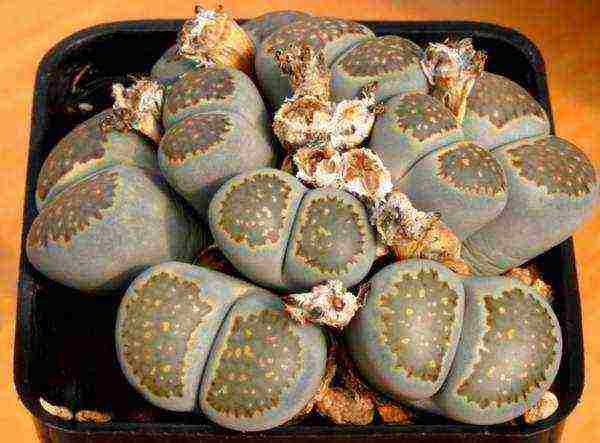
Lithops salt tolerant Lithops solicola photo How to care
Outwardly, it looks like a slingshot, which is stuck into the ground. The upper side is darker than the lateral ones. During flowering, a chrysanthemum-shaped snow-white flower shoots.
Lithops beautiful Lithops bella
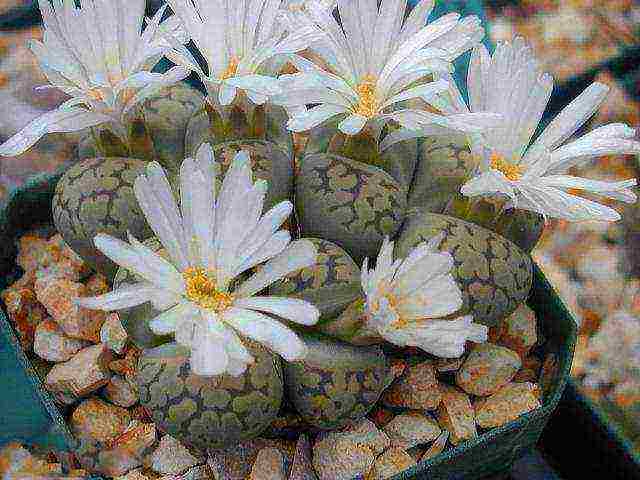
Lithops beautiful Lithops bella photo Growing and care at home
A deep rift is visible between the olive-gray leaves. The pattern on the surface is formed by thick broken lines, and flowering is accompanied by a pleasant aroma.
Lithops fuller
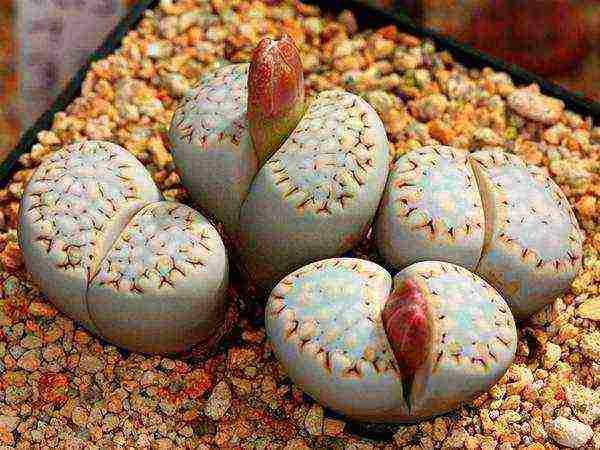
Lithops Fuller Lithops fuller maintenance and care Photo of succulents
Height does not exceed 1.5 cm. Leaves are gray-blue or brownish-yellow with a convex top surface covered with brownish-green pattern and red-brown spots. The flower is a white daisy.
Lithops Optics Lithops Optica

Lithops Optics Lithops Optica photo How to grow and care for a cactus lithops photo
These stones are painted in a lilac-lilac tone, and the inner surface is slightly lighter and does not grow more than 3 cm. A white flower with yellow stamens is located deep in a crevice.
Lithops Olive green Lithops Olivaceae

Lithops Olive green Lithops Olivaceae how to care photo
Its shape resembles a heart with cut tops. These are greenish-gray pebbles with whitish chaotically located specks. Delicate yellow buds are located on light green peduncles.
Lithops Marble Lithops Marmorata

Lithops Marble Lithops Marmorata growing and care at home photo
Their upper gray-greenish surface, dotted with many gray lines, looks velvety. Chamomile flowers bloom after rain.
Lithops Lesliei

Lithops Leslie Lithops Lesliei how to grow indoors photo
Its fleshy leaves are strongly shortened, gray-blue in color with a shallow arcuate crack. Their flat part is dotted with a fine mesh pattern.
Lithops Brownish Lithops Fulviceps

Lithops Brownish Lithops Fulviceps growing and care in indoor conditions photo
Irregular spots are scattered over the coffee-brown flat surface of these stones, giving the impression of a squeezed out irregular grid. The diameter of the yellow flower reaches 3 cm.
Lithops Aucamp Lithops Aucampiae
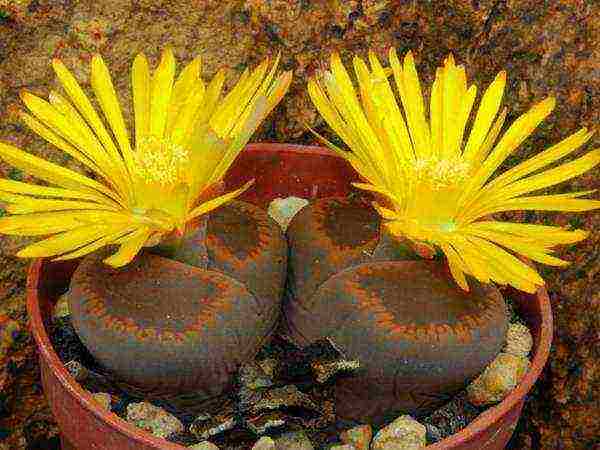
Lithops Aucamp Lithops Aucampiae cultivation and care at home photo
Intense chocolate shade with lighter blotches of leaves resembles chocolate truffles.
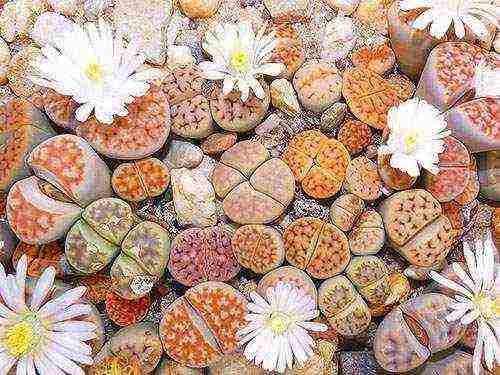 The discovery of these amazing plants belongs to William Burchell, an English botanist and naturalist who traveled in September 1811 through the desert in the South African region of Prisca. In a book published later, the scientist gave a drawing of the discovered plant. The traveler was helped to notice the lithops, which looked like round pebbles, between the stones, a fluke, so good was the disguise.
The discovery of these amazing plants belongs to William Burchell, an English botanist and naturalist who traveled in September 1811 through the desert in the South African region of Prisca. In a book published later, the scientist gave a drawing of the discovered plant. The traveler was helped to notice the lithops, which looked like round pebbles, between the stones, a fluke, so good was the disguise.
 How to grow lithops at home? Is the care and maintenance of these unusual plants difficult?
How to grow lithops at home? Is the care and maintenance of these unusual plants difficult?
Lithops - living stones of the desert
Lithops managed to hide from the close attention of botanists for about a hundred years, because their today's name, derived from "lithos" - stone and "opsis" - look, the plants received only in 1922. Today, six dozen species have been discovered and described, outwardly, indeed, resembling stones of all kinds of plant colors, opening yellowish or white flowers in the fall.
 But the "stone" look of lithops is deceiving.
But the "stone" look of lithops is deceiving.
Two thick, intergrown sheets, of which the aerial part consists, are literally filled with moisture.
This is a kind of reservoir where the plant stores the water supply that is so necessary in the desert, which ensures the growth, development of the bud, flowering and reproduction of Lithops. The dimensions of the amazing "living stone" are modest, most species barely reach 5 cm in diameter. The leaves are attached to an inconspicuous, short stem, and the plant feeds on a long taproot. Nevertheless, at home, lithops are grown from seeds, and the grown "pebbles" delight the owners for many years.
 In order for pets to feel comfortable in an apartment, it is important to provide proper care. Otherwise, it is difficult to wait for the "living stones" to bloom, and sometimes the plants die altogether.
In order for pets to feel comfortable in an apartment, it is important to provide proper care. Otherwise, it is difficult to wait for the "living stones" to bloom, and sometimes the plants die altogether.
Lithops care at home
 If the care and maintenance of lithops is to their liking, they bloom regularly, their leaves are elastic and change to new ones about once a year. When the plant gets enough light, water and nourishment, it sits firmly in the soil and consists of a pair of leaves. As they grow, they begin to "lose weight" and dry out, and a new pair begins to appear through the gap.
If the care and maintenance of lithops is to their liking, they bloom regularly, their leaves are elastic and change to new ones about once a year. When the plant gets enough light, water and nourishment, it sits firmly in the soil and consists of a pair of leaves. As they grow, they begin to "lose weight" and dry out, and a new pair begins to appear through the gap.
As a native to the desert, lithops need year-round lighting. At home, it is better to place pots with these plants on the southern windows, but if this is not possible, it is possible to grow lithops at home only in a greenhouse with constant artificial lighting.
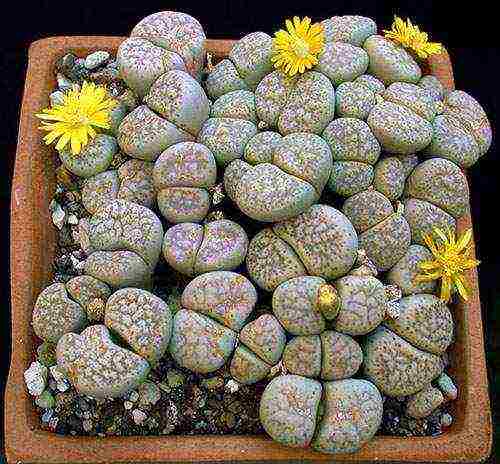 Summer temperatures prevailing in the middle lane, of the order of 20-24 ° C, are quite acceptable for guests from South Africa, because they perfectly endure forty-degree heat. The main thing is that pets forced to experience high temperatures do not additionally fall under direct sunlight.At home, lithops with especially hot periods fall from a semblance of hibernation, restoring vital processes only at night, when the desert cools down. How to grow lithops in an apartment?
Summer temperatures prevailing in the middle lane, of the order of 20-24 ° C, are quite acceptable for guests from South Africa, because they perfectly endure forty-degree heat. The main thing is that pets forced to experience high temperatures do not additionally fall under direct sunlight.At home, lithops with especially hot periods fall from a semblance of hibernation, restoring vital processes only at night, when the desert cools down. How to grow lithops in an apartment?
In the warm season, lithops can be taken out into the garden or on the balcony, not forgetting to protect the pots from the sun. In the hottest months, the pots are shaded by 20-30% during the daytime. The rest of the time, sun protection is needed only when the rays are directly hitting the plants. In winter, a hibernation period begins for plants. At this time, a comfortable temperature will be about 10–12 ° С, but not lower than –8 ° С, otherwise the liquid inside the thickened leaves begins to freeze and destroy cells.
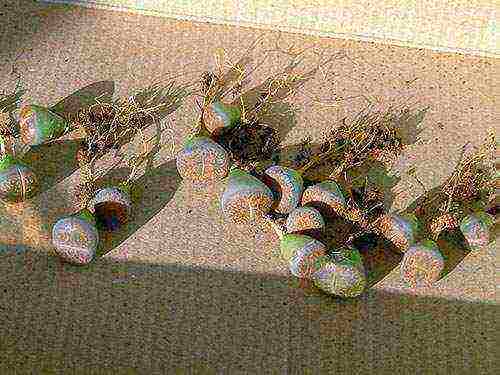 Caring for lithops at home is not complete without transplanting grown plants. When the root system of lithops fills its allotted volume, the plant is transplanted, choosing wide pots for this culture, slightly deeper than the length of the main root of the flower. Since lithops does not tolerate stagnant moisture, a drainage layer must be made at the bottom, and after transplanting the plant, greenhouse conditions are created for 2–6 weeks, carefully monitoring the soil moisture, the absence of drafts and the lighting regime.
Caring for lithops at home is not complete without transplanting grown plants. When the root system of lithops fills its allotted volume, the plant is transplanted, choosing wide pots for this culture, slightly deeper than the length of the main root of the flower. Since lithops does not tolerate stagnant moisture, a drainage layer must be made at the bottom, and after transplanting the plant, greenhouse conditions are created for 2–6 weeks, carefully monitoring the soil moisture, the absence of drafts and the lighting regime.
If lithops are very sensitive to a lack or excess of moisture, then the composition of the soil for them can be almost any. It is only important that the substrate can retain the amount of water required by the plant, and is moderately nutritious.
The approximate soil composition for this species may include:
- two pieces of leafy land;
- part of the clay;
- two parts of washed sand;
- a small amount of peat.
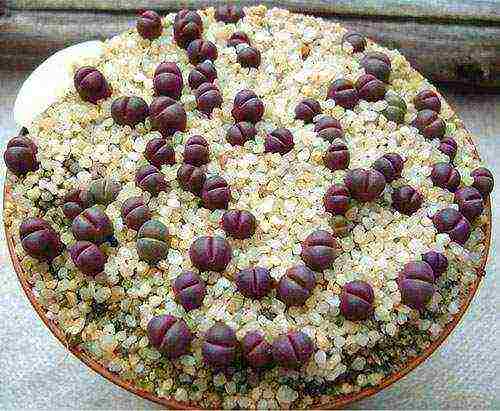 After planting lithops, the soil surface is sprinkled with small pebbles, crushed shells or other mulching agent that prevents moisture evaporation and the development of mosses and molds on the soil. Lithops can be fed once every two years, if the plant has not been transplanted into new soil during this period. In this regard, care, like the maintenance of lithops, is not burdensome and simple.
After planting lithops, the soil surface is sprinkled with small pebbles, crushed shells or other mulching agent that prevents moisture evaporation and the development of mosses and molds on the soil. Lithops can be fed once every two years, if the plant has not been transplanted into new soil during this period. In this regard, care, like the maintenance of lithops, is not burdensome and simple.
Features of watering lithops
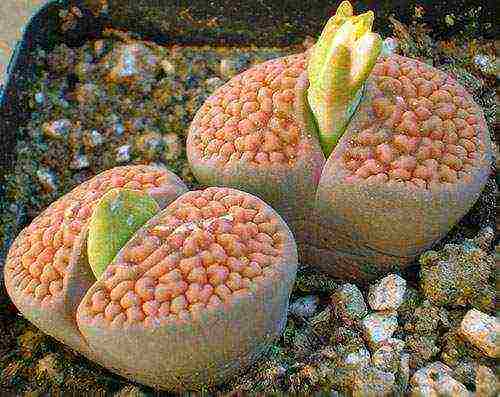 If, with a lack of moisture, lithops can live for some time at the expense of a reserve in the leaves, then excessive watering, and especially stagnant water, quickly leads to decay of the root system.
If, with a lack of moisture, lithops can live for some time at the expense of a reserve in the leaves, then excessive watering, and especially stagnant water, quickly leads to decay of the root system.
In order for the plant to constantly feel comfortable, you need to choose the right watering regime and be very attentive to the state of the "living stone". This is the main part of lithops home care:
- When lithops changes old leaves for new ones or picks up buds, it needs the most abundant watering.
- But in winter, with the onset of a dormant period, the soil is only occasionally moistened or watering is stopped altogether.
 From mid-April to December, lithops can be watered after 10 days, but the plant itself can tell when it lacks moisture. Such a signal will be the wrinkling of the leaves during the daytime, which persists the next morning. On especially hot days, the maintenance and care of lithops becomes more difficult. Plants are given an evening shower, sprinkled with warm water.
From mid-April to December, lithops can be watered after 10 days, but the plant itself can tell when it lacks moisture. Such a signal will be the wrinkling of the leaves during the daytime, which persists the next morning. On especially hot days, the maintenance and care of lithops becomes more difficult. Plants are given an evening shower, sprinkled with warm water.
With the beginning of wintering, watering is stopped. It needs to be renewed in February, at which time the plants can receive water once every three weeks or a little more often if the process of opening the gap between the old leaves is too delayed.
When watering, it is important to prevent moisture from entering the gap between the leaves, and so that the drops remain on the sides of the lithops. This can cause sunburn or tissue rot. If the regular watering is moderate, once a month the soil in the pot is soaked well, which mimics the rainy season and serves to develop the root system. It is watering, the most important part of lithops care at home, that determines the vitality of old leaves and the appearance of lithops. If the plant receives a lot of water, its excess accumulates in the aerial part, as a result, the leaves that have outlived their life do not die off and spoil the appearance of the plant.
Growing lithops from seeds at home
 If you want to get young lithops from seeds, it is better to sow at home in March.
If you want to get young lithops from seeds, it is better to sow at home in March.
Before growing lithops, prepare a substrate based on:
- one part of red brick crushed to 2 mm;
- two parts of sod land;
- two pieces of sand;
- one part of clay and the same amount of peat.
Then the soil is steamed, mixed, cooled and loosened again. When filling the pot at 25–30% of the height, a drainage layer is made of fine gravel, and then the soil is covered and moistened.
Seeds are soaked for the fastest hatching for 6 hours and, without drying, are sown on the surface of the prepared soil.
Now the development of young lithops at home depends only on caring for them. After sowing, the container is covered with glass or foil and placed in a warm, lighted place for germination. In order for the seeds to sprout better, it is better to immediately provide conditions close to natural.
- During the day in the greenhouse or in the area of the container it should be 28–30 ° С, and at night only 15–18 ° С.
- Once or twice a day, the film is removed and the crops are aired for a couple of minutes.
- When the soil dries up, it is moistened with a spray bottle.
 After 6-12 days, you should wait for the first shoots and prepare for a new phase of caring for lithops at home. When tiny sprouts appear above the ground, you need to ventilate them up to 4 times a day, gradually increasing the procedure time to 20 minutes. It is important that the air in the greenhouse does not warm up above 40 ° C, and the direct rays of the sun do not fall on the seedlings. If there is not enough light, after a few days the plants will signal a faded color.
After 6-12 days, you should wait for the first shoots and prepare for a new phase of caring for lithops at home. When tiny sprouts appear above the ground, you need to ventilate them up to 4 times a day, gradually increasing the procedure time to 20 minutes. It is important that the air in the greenhouse does not warm up above 40 ° C, and the direct rays of the sun do not fall on the seedlings. If there is not enough light, after a few days the plants will signal a faded color.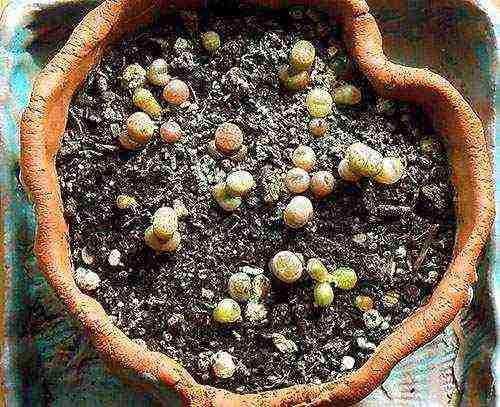
When the size of young lithops is equal to a pea, the surface of the soil in the pot is carefully mulched with small pebbles. And at the first traces of mold or moss on the soil, they are treated with a solution of potassium permanganate.
Despite the difference in the growth rate of home-grown lithops species, six months after sowing, it is time for the first change of leaves. This means that the plants are limited to watering, which is resumed only after the old leaves are completely dry. If small lithops develop better when there is some distance between them, then adult "living stones" are planted close to each other, leaving gaps of no more than 2-3 cm. The first transplant of seedlings can be carried out a year after planting, in a substrate for adult lithops. the maintenance and care of which is not so difficult.
Collection of lithops in a greenhouse - video

Lithops are original flowers belonging to the genus of succulent plants. People also call them "living stones". They grow in the sandy deserts of the African continent. There are more than 40 varieties of lithops, but only 15 of them are suitable for breeding as a houseplant. Given the characteristics of this flower and following the rules, it can simply be grown in indoor conditions. The article describes how lithops reproduce by seeds and how to grow them correctly.
…
When to start growing live stones?
Vegetative reproduction of lithops is possible, but they are mainly grown from seeds. In order to grow healthy lithops, the life cycle of the flower must be taken into account. It is directly related to the length of daylight hours.
Reference. When grown in an apartment, the life cycle of the plant may shift slightly.
The dormant period of the lithops plant falls in the summer.when the longest daylight hours. At this time, a drought occurs in the homeland. But at the end of August, the flower wakes up and blooms. After flowering, leaves begin to change. And only at the end of February, old leaves completely give way to young shoots. It is at this time that sowing of young seeds is recommended.
Step by step instructions on how to grow at home
Germinating Lithops seeds is a painstaking business. However, observing certain rules, a novice gardener will be able to cope with it. The main thing is to properly prepare and take into account the characteristics of this plant.Sowing seeds can be carried out from late autumn to late spring, but the most favorable period is considered to be the beginning of March.
Priming
The first step is to prepare the ground. For sowing lithops, the usual peat soil is not suitable. It is necessary to prepare a special mixture that is as similar as possible to the desert soil native to lithops. To prepare it, you need to take:
 1 part of crushed red brick (the size of the fragments should be about 2 mm);
1 part of crushed red brick (the size of the fragments should be about 2 mm);- 2 parts of sod land;
- 2 pieces of sand;
- 1 part clay;
- 1 part peat.
Stir the ingredients and bake in the oven, then cool and loosen well. At the bottom of the pot, you need to pour drainage from fine gravel, about 25-30% of the height, then the harvested soil and moisten it well. After that, the soil is ready for planting seeds.
Recommendation. Adding ash to the soil mixture will prevent rotting.
For growing lithops at home it is better to choose a pot that will not taper towards the bottom. It's good if it's a wide bowl. The choice of such dishes will provide good ventilation and moisture permeability.
Landing
When choosing seeds, you need to know their age. Lithops seeds remain viable for 10 years, however, they best germinate in the third year of storage. How to plant and how to germinate seeds?
- The seeds must be soaked before planting. To do this, they are placed in a manganese solution for 6 hours, but not more.
- How to plant? After that, they need to be distributed over the surface of the soil without drying. After planting them, you do not need to sprinkle them with earth on top.
- To create comfortable conditions, the sown seeds are covered with foil or glass. The container should be well lit, but it should not be in the scorching sun.
From the video you will learn how to sow lithops at home:
Leaving for the first time
A certain microclimate is required for seed germination. When creating it, it is necessary to focus on the conditions in the natural habitat.
Temperature and lighting
Seeds germinate at a temperature of 10-20 degrees. In this case, it is desirable to create temperature drops during the night and daytime. During the day, you need to adhere to a temperature of 28-30, and at night 15-18. This will create conditions that approximate the habitat of lithops in nature.
Important! Lithops do not like high temperatures in confined spaces. It is imperative to ensure the flow of air.
If the seeds were planted in the summer, at the age of one month, you can leave them open or make the shelter spacious enough - at least 10 times the size of the bowl in which they grow.
Lithops needs bright lighting all year round. If there is not enough light, the leaves will stretch out and darken.
Air humidity
 Once or twice a day, you need to open the seeds, ventilate them for 2-3 minutes and spray them with a spray bottle. It is important that the water droplets are not large, they must imitate dew, otherwise the plant will die from rot. Lithops do not like waterlogging, there is no need to water the ground. With this care, the seeds will germinate in 6-10 days.
Once or twice a day, you need to open the seeds, ventilate them for 2-3 minutes and spray them with a spray bottle. It is important that the water droplets are not large, they must imitate dew, otherwise the plant will die from rot. Lithops do not like waterlogging, there is no need to water the ground. With this care, the seeds will germinate in 6-10 days.
After the seedlings have emerged, the number of airings can be increased up to 3-4 times a day, and the airing time can be extended to 20 minutes. Now the soil can not be moistened every day; this should be done only as needed. Moisten only if the soil surface is dry.
Transfer
After the seedlings emerge, the soil can be mulched with small pebbles. First, it will give support to young plants prone to lodging. Secondly, it will prevent rot.
Seedlings need to dive only if they are cramped. However, experts recommend not to do this before the plant overwinters for the first time. In addition, even an adult lithops does not need frequent transplants. If the need for a transplant has arisen, it is better to do this during a period of active growth.
Recommendation. Lithops does not like growing alone. It is advisable to plant them in a group of several or with other undersized succulent plants. It has been proven that they grow much better this way.
Watering and feeding
Watering an adult plant must be very careful. It is better to pour water with a spoon into the soil near the seedlings, or just put the pot for a while in a pan with water. The root system of Lithops is very developed and he himself will take nutrients from the soil. It is necessary to ensure that water does not fall into the hollow between the leaves - this can lead to rotting of the plant. In the autumn-winter period, lithops do not need to be watered at all.
Lithops, like other succulents, is very hardy and does not need constant feeding.... It may be needed only if the plant has not been transplanted into new soil for many years.
From the video you will learn about the features of watering lithops:
Photo
Next, you can take a look at the photo and see how lithops grown from seeds look like:

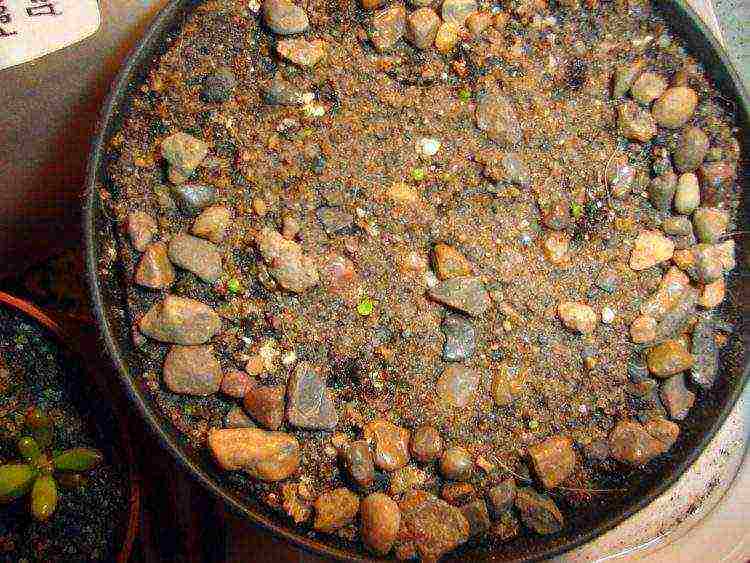
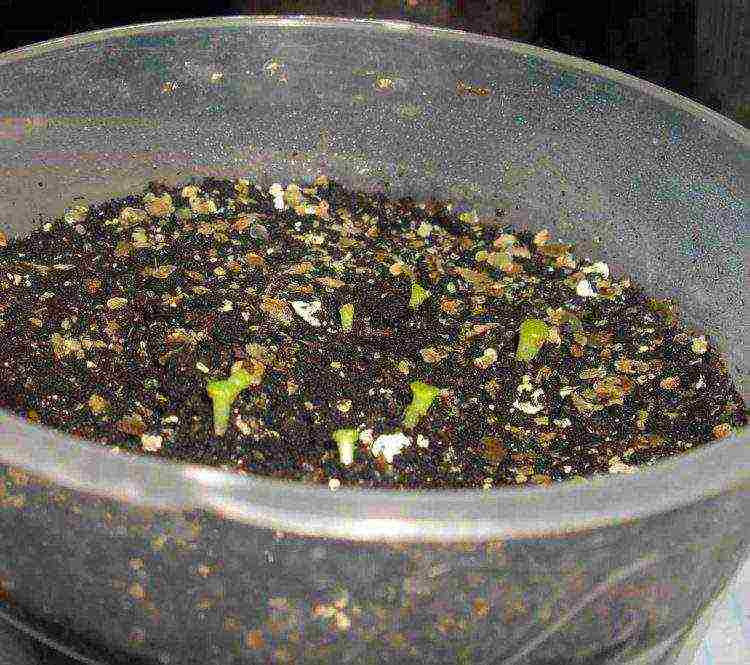

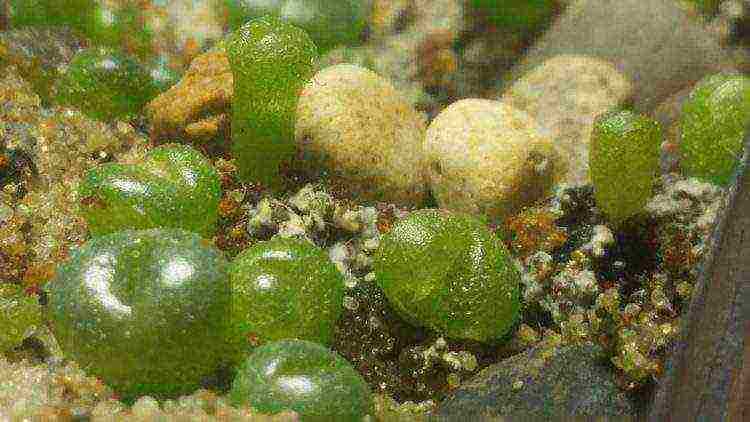
Can I plant outdoors?
Between May and September, lithops can be brought into the fresh air. This will harden the seedlings and promote flowering. However, you should not plant them in open ground.
Reference. In winter, they can simply freeze; frequent transplants from the pot and back will not be pleasant to him. In addition, rains can fall into the hollow between the leaves, which is harmful for lithops.
Why isn't it growing?
For the proper development of the plant, you need to carefully monitor the moisture content of the soil. Lithops comes from arid places and does not like stagnant moisture, therefore, abundant watering is contraindicated for him. Sometimes it can be wiped with a damp cloth, but no water should remain on the surface of the plant.
Often it is violation of the irrigation regime becomes the reason that the small lithops stops growing. If, nevertheless, the soil was waterlogged, it is necessary to completely stop watering and wait until the soil is completely dry.
Disease can also cause stunting. Lithops are quite resistant to disease, especially in hot weather. However, as the temperature drops, they become more susceptible. The most common pests for lithops are:
- Aphid. She sucks the juice from the leaves. In the initial stages, an infusion of hot pepper or garlic will help fight it, but if more serious measures are needed, insecticides (Actellik or Aktara) can be used.
- Spider mite... When a white bloom appears, the plant should be treated with Actellik's solution. Process every 5-7 days.
- Mealybug. If the disease is noticed in the early stages, you can wash the plant with soapy water. In a more advanced case, treatment with Aktara or Phosphamide will help. Process once a week.
- Root rot. To combat it, you need to dig up the plant, examine the roots and remove the areas damaged by the disease. The treated plant roots are immersed in a 2% solution of Bordeaux liquid for half an hour, after which the lithops can be planted in new soil.
Lithops are amazing plants that amaze with their appearance. They are quite unpretentious to care for, however, with comfortable conditions created, they can grow into a whole colony, capable of delighting with bright flowering.
 A house plant such as lithops (their Latin name is lithops pseudotruncatella) can become a real decoration of the interior. This is an unusual and very interesting representative of the fauna from the southern hemisphere of our planet, original in appearance, as it resembles an ordinary pebble. By the way, it got its name due to this, because the word Lithops in translation from Greek means “like a stone”. The plant disguises itself as a stone for self-preservation so that herbivores do not eat it.
A house plant such as lithops (their Latin name is lithops pseudotruncatella) can become a real decoration of the interior. This is an unusual and very interesting representative of the fauna from the southern hemisphere of our planet, original in appearance, as it resembles an ordinary pebble. By the way, it got its name due to this, because the word Lithops in translation from Greek means “like a stone”. The plant disguises itself as a stone for self-preservation so that herbivores do not eat it.
Lithops are found on arid rocky surfaces around Namibia, Botswana and South Africa.These original plants became known relatively recently, namely in 1815, when the English naturalist biologist John Burchell first discovered them.
How to care for lithops and in what conditions should they be kept? How to sow these unusual plants? All this will be discussed in detail below.
Description of lithops: characteristics and features
Lithops are easily recognizable among other plants: they consist of two dense, fleshy leaves about 2 cm thick, between which there is a small space. The leaves themselves are connected to each other and have a different surface, depending on the type (convex, flat or conical).
Due to their natural necessity, lithops have not only the shape of a stone, but also characteristic shades of the surface on which they grow: gray, grayish-green, brown, brown, and so on. In addition, there are corresponding patterns on the leaves. Over time, the leaves dry out and new ones grow in their place.
The depth of the space between the leaves can also be different: from a small crevice to a deep one that reaches the ground. In late summer and early autumn, a beautiful yellow or white flower, reminiscent of a chamomile or gerbera, begins to sprout from this small space. This is another reason why the plant got its name "living stone". The flowering period begins approximately 3 years after sowing the seeds. The life span of a flower is 5-10 days, its size can sometimes exceed the leaves themselves.
Generally "Living stones" grow very slowly... Like cacti, they are deeply rooted in the earth, extracting moisture from its deep layers. In the natural environment, during a dry period, such roots are even able to pull the plant into the ground in order to prevent moisture loss from the surface of the leaves in an unfavorable season.
Some features of lithops
By the way, all plant lovers who want to breed lithops at home need to know about the peculiarities of the life of these living stones in order to properly care for them and keep them, in fact, in an unusual environment for them. And, despite the fact that for many years this plant has been grown in the Northern Hemisphere of the planet, its memory is still working according to the biorhythms of the Southern Hemisphere. That is, in the homeland, the flowering period falls in the spring, at which time autumn comes in the Northern Hemisphere. Accordingly, the lithops home flower will bloom with the arrival of autumn.
What are the varieties
Florists know about 37 species of this unusual plant., but the most common among them are the following:
 aukamp - this species is distinguished by greenish-gray shades of leaves with dark patterns, sometimes a brownish tint is found. The yellow flower does not exceed 4 cm in diameter;
aukamp - this species is distinguished by greenish-gray shades of leaves with dark patterns, sometimes a brownish tint is found. The yellow flower does not exceed 4 cm in diameter;- flattery - the color of the leaves can be different, most often it is green in different shades. In the fall, a white flower blooms, exuding a pleasant aroma;
- brownish - here the name speaks for itself: the color of the leaves in this species is mainly brown, and greenish is also found. There are patterns in the form of specks. In autumn, it releases a small yellow flower;
- marble - the color of the leaves is gray-green, and their surface is decorated with a marble pattern of a darker shade. The flowers are 5 cm in diameter, they are always white and smell nice;
- olive green - dense rounded leaves have a diameter of 2 cm, their color varies from olive to green (as the name of this variety indicates), brown representatives are also found. On the surface of the leaves there is a pattern in the form of strokes and specks that merge together. Yellow flowers appear from the space in the middle during the flowering period;
- optics - in this species, the leaves have a rounded streamlined shape, more they resemble one leaf bent in half. Their color is both green and lilac-pink. The flowers are always white.
Lithops care: seeds, planting, cultivation, watering and multiplication
Landing first... Lithops can grow in different soil: both dry sandy and very nutritious. You can also mix the universal primer with various additives, such as sand, marble or brick chips, and so on. By the way, this option is suitable if the "living stone" will be located mainly in the sun. If the conditions are moderate, you can mix the soil in the following proportions:
- 60% -70% - mineral components;
- 30% -40% - universal soil or leaf humus.
Lithops: reproduction
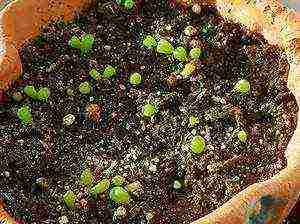 Reproduction of these unusual plants occurs exclusively with the help of seeds. How to grow lithops from seeds at home? To do this, the seed must be soaked in water for about 6 hours, then put it on the surface of the prepared soil (it is not necessary to deepen and drip in). Cover the pot with a transparent container or cover with polyethylene, the temperature inside such a greenhouse should not fall below 28 degrees. Periodically, the seed will need to be ventilated and sprayed.
Reproduction of these unusual plants occurs exclusively with the help of seeds. How to grow lithops from seeds at home? To do this, the seed must be soaked in water for about 6 hours, then put it on the surface of the prepared soil (it is not necessary to deepen and drip in). Cover the pot with a transparent container or cover with polyethylene, the temperature inside such a greenhouse should not fall below 28 degrees. Periodically, the seed will need to be ventilated and sprayed.
After 6-10 days, seedlings will begin to appear from the seed, and then spraying will need to be stopped, but it is necessary to ventilate more often and a little longer.
Spring sapling can be transplanted into a permanent pot. Several seedlings can be planted in one pot, leaving a distance between them equal to half the diameter of the lithops.
Sowing lithops can be done at any time of the year, provided that all recommended rules are followed.
Features of caring for "living stones"
Caring for lithops at home is really simple: it just needs provide them with appropriate conditions:
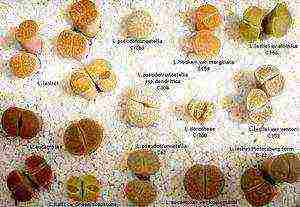 since a "living stone" is a southern plant, it means that it must be kept on the southern side of the dwelling, preferably if there will be a lot of sunlight;
since a "living stone" is a southern plant, it means that it must be kept on the southern side of the dwelling, preferably if there will be a lot of sunlight;- lithops do not like changing places, they do not even like it if their pot starts to be turned in the other direction;
- these plants will like hot temperatures and dry air, all this again they need because of their southern origin;
- the optimum temperature of the content is + 22-25 degrees, the minimum should not drop below +12 degrees;
- lithops does not tolerate excess moisture, since it is filled with it as much as possible and can burst when oversaturated;
- in the period from May to September, "live stones" need to be watered moderately and rarely enough, and in September watering can be stopped altogether until the leaves begin to renew;
- in March-April, the old wrinkled leaves are replaced by new ones, and during this period watering can be resumed.
"Living stones" are unpretentious in care and do not require constant feeding. Only sometimes they need additional care if the plant has not been transplanted for a long time, or the soil in which it grows has been depleted.
One of the conditions for caring for lithops is a transplant, which, however, happens quite rarely: only once every 4-5 years. That is, such a procedure should be done only as needed. The prerequisites for the transplant are as follows:
 the lateral roots of the plant must be cut off;
the lateral roots of the plant must be cut off;- a wide and shallow pot is chosen as a suitable pot;
- drainage is covered at the bottom of the pot;
- the soil for lithops should consist of equal parts of leafy earth, clay, sand and brick chips.
It is impossible to grow lithops in peat or purchased soil for cacti.
Diseases and pests: how to deal with them
In winter lithops can be attacked by scale insects. To eliminate them, it is necessary to lubricate the leaves of the plant with a mixture of soapy water and chopped garlic.
If lithops leaves are lethargic and lifeless, you need to water it a little. At the same time, one must always remember that it is an excess of moisture that can destroy this exotic plant.
Lithops or "living stones" are very unusual and interesting plants that will decorate any home.With proper care, they will always delight the grower with their dense massive leaves and beautiful flowers.
